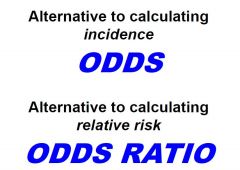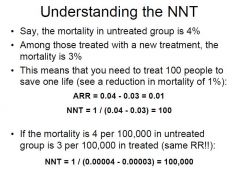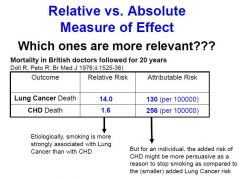![]()
![]()
![]()
Use LEFT and RIGHT arrow keys to navigate between flashcards;
Use UP and DOWN arrow keys to flip the card;
H to show hint;
A reads text to speech;
32 Cards in this Set
- Front
- Back
|
Relative risk =
|
Iold/Inew
|
|
|
Odds ratio=
|
Oddsold/Oddsnew
|
|
|
Absolute risk reduction
|
Iold - Inew
|
|
|
NNT =
|
1/(Iold - Inew)
OR 1/ARR |
|
|
What is efficacy? How is it calculated?
|
how much of the risk in control group is reduced by the new treatment.
ARR/Iold |
|
|
The odds ratio is an alternative to ___
|
RR
|
|
|
You can use relative or absolute measures of effect. Explain and when is each one useful.
|
Relative are very informative for causation strength.
Absolute is very informative with regards to the total risk reduction associated with a treatment |
|
|
Do relative or absolute measures measure the magnitude?
|
absolute
|
|
|
What allows you to compare both relative and absolute measures?
|
efficacy
|
|
|
Relative or absolute?
1. most relevant for etiology. 2. attributable risk. 3. most relevant to evaluate actual treatment/risk to exposed individuals. |
1. relative.
2. absolute 3. absolute |
|
|
why can't you only analyze the treatment of actual treatment when there is crossover?
|
violate principles of random
|
|
|
besides upholding randomization, why is it important to use intention to treat for analysis?
|
because crossover may be heavily due to adverse effects of treatment
|
|
|
List the three main limitations of randomized clinical controlled trials.
|
not always feasible of ethical.
limited generalizability. statistical uncertainty |
|
|
what is an alternative to incidence? to relative risk?
|

|
|
|
explain NNT.
|

|
|
|
compare relative, absolute, and combination factors.
|

|
|

think about when each is relative.
|
good work.
|
|
|
what is a parameter
|
When you want to know if one treatment is better, you want to know by how much this treatment is better!
|
|
|
is standard error bigger or smaller if you have a big sample size
|
smaller
inverse relationship |
|
|
describe type one error
|
when you think there is a difference when in fact there is not
associated with false positive and p value |
|
|
describe type II error
|
when you think there is no difference when in reality there IS!
associated with false negative and beta probability |
|
|
is type I or type II error more common? why?
|
type I error is more common because there is only one null hypothesis and many alternative hypotheses!
|
|
|
what is the null hypothesis in the case of ARR? In RR?
|
0
1 |
|
|
how do you account for type I error?
|
in your pvalue
|
|
|
give the wording for the p value
|
the probability that the difference in our findings this large or larger from the null hypothesis would only occur __% of the time IF the null were in fact true
|
|
|
in order to find your pvalue what do you do to z?
|
you double it
|
|
|
give a definition for confidence interval
|
the range of values in which you would find your mean parameter 95% of the time
|
|
|
what can the CI NOT include if you want to say your null is untrue
|
you can't include your null hypothesis value
|
|
|
what three things does statistical power depend on?
|
magnitude of findings
set alpha value sample size |
|
|
how do you caluclate chi square
|
sum of ....(O-E)^2 / E
|
|
|
how do you calculate SD?
|

like this!
|
|
|
how do you relate a p value and a z score?
|

Find z. Double it. This is P!
|

